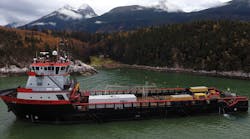Latest from FTTx/Optical Networks
AP&T’s 86-Mile Alaskan Undersea Cable Project:
It was a dark and stormy night. At the end of which revealed a well-lit vessel anchored offshore in Lutak Inlet, Alaska. Despite the clouds and threat of rain, the morning of September 23, 2016, signaled the dawn of a brighter future for Alaskan’s Upper Lynn Canal residents craving network speeds that only fiber can deliver.
AP&T’s Lynn Canal (Undersea) Fiber project links the communities of Juneau, Haines, and Skagway, with a 1" Diameter, 36-fiber cable, providing the Upper Lynn Canal region of Alaska with 7,000 times the data transport capacity previously available via AP&T’s terrestrial Southeast Alaska Microwave Network.
While standing on the deck of the boat, Fiber Tech Rick Chislett delicately fed a glass fiber the thickness of a human hair into a piece of electronic equipment — and there was light. "The first one’s OK," he said after a minute. "We can see Juneau." What Chislett meant was that he could literally see flashes of laser light sent 71 miles to the capital city and back via the Optical Time Domain Reflectometer (OTDR) he was using.
Rick and his 21 teammates worked on The Lynn Canal Fiber project from September 21 through September 24 for the cable lay operation, with splicing and testing taking an additional week with Rick and 2 other teammates. The project brought together an international coalition of partners contracted by AP&T. NSW out of Germany (a subsidiary of General Cable) provided a turnkey solution and enlisted fiber techs from International Telecom out of Montreal. The efforts also involved the cable laying vessel Silver Arrow, which is part of the worldwide Horbeck Offshore Fleet of maritime operations.
The Realities of Deploying Undersea Cable
How’d they get it done before the winter set in? In early fall, the Silver Arrow took aboard 336 tons of cable in the Port of Tacoma, Washington, and headed to Lena Point, Alaska. The 1,040-mile trip ensued without incident. As noted, the expertise of the coalition brought together to accomplish the 86-mile deployment of undersea fiber made it look easy: in just 4 short days, with 4 cable landings, and in spite of inclement weather the first day out of Juneau on their way north to Haines and Skagway.
Making landfall on the final leg in Smuggler’s Cove near Skagway. Each time the heavily-armored undersea cable makes its dry land appearance, fiber technicians with project partner International Telecom make the sparks fly, cutting through the exterior protective jacket and 4 armored layers in order to extricate the delicate glass fibers encased within.
When the ship arrived, a team of 21 workers, including the ship’s crew and on shore AP&T employees as support, quickly got to work.
The project to deploy the 86 miles of 1-inch-diameter armored undersea fiber was not without its challenges.
Challenge #1: Site control at Lena Point/Juneau
Although there was already an easement designed for access to subsea cables, recurring costs for access became cost prohibitive. The solution was to purchase an adjacent piece of property, including a home, to establish an easement that included multiple runs of 4" HDPE conduits and a communications building to house transport and interconnection equipment. Our plan was to resell the home after the easement was established and construction work was completed.
Amid shadows of Tacoma’s giant shipside gantry cranes, the meticulous process of hand-guiding 454,000 feet of 1-inch armored fiber optic cable into its reinforced metal "nest" aboard the Silver Arrow begins. 336-tons later, it’s bon voyage as the bow aims north on its journey to Juneau for deployment of the first leg of the 86-mile LCF project.
Challenge #2: To gain access acrossmChilkat State Park
This park’s boundaries extended beyond the shore line, and essentially blocked any type of cable laying activity to the upper Lynn Canal region. We worked with the Division of Parks and Recreation, then with the State Attorney General’s office, to work out an acceptable solution. Although an agreement was reached, the time it took to work through the process put the construction window out of seasonal opportunity and we were forced to postpone the project until the following year (2016). The cable was transported and stored at a location in Tacoma, Washington, at an additional cost of approximately $700,000.
Challenge #3: Archaeological concerns at the landing site, Smuggler’s Cove, at Skagway.
It was a site that had been used not only by local native tribes, but also saw much use during the Klondike Gold Rush days (1896-1899). We worked with the State Historic Preservation Office and local Parks and Recreation officials to develop an archaeological dig plan and post-construction site restoral. We contracted the archaeological service of Dowl Engineers (Anchorage) who provided all the technical expertise to see the process through. While placing the HDPE pipe and beach manhole, an archaeologist was on site to monitor digging activities. Nothing of significance was dug up, just a few old bottles and a piece of leather. We then reworked the area, placing drift wood and rocks back in their original places, and also improved a local access road for the City of Skagway. After some tidal action, it is barely discernable where the digging took place.
Technicians and shipboard crew man the stern of the GPS-guided Class II vessel Silver Arrow carefully monitoring and responding to diver and shoreside communications to ensure a safe and efficient deployment of the second LCF cable landing just inside Lutak Inlet, near Haines.
Thankfully, the team was on a mission to success. After spending nearly $11 million and years in development, Alaska Power and Telephone’s Lynn Canal Fiber linking Skagway and Haines to Juneau, and possibly the Yukon, was completed.
On the horizon for 2017-2018 are plans to invest another 1.5 million dollars in land-based outside plant fiber infrastructure in the region. "The potential to empower the lives and livelihoods of residents in this region translates into AP&T’s ability to ignite opportunity," stated Michael Garrett, AP&T’s President and CEO.
Endnote:
Elements of this story were taken with permission from original reporting on September 25, 2016, by the daily newspaper Juneau Empire.
From ship to shore. The final few feet of AP&T’s 86-Mile Lynn Canal Fiber Cable makes landfall, emerging from an underground concrete cable vault shoreside in Smuggler’s Cove near Skagway. A line of buoys off the stern of the cable-laying ship Silver Arrow marks the submerged path of the cable route shoreward.
AP&T personnel and representatives from cable supplier and project partner NSW were on hand to ensure each foot of AP&T’s 86-Mile Lynn Canal Undersea Fiber cable was carefully wound into place such that the process, done in reverse at sea, would go off without a hitch.
Shielded from the elements typical of an Alaskan autumn, AP&T and International Telecom fiber techs "split hairs" of glass as they put each strand of fiber through its paces using an OTDR. This piece of test equipment allows technicians to characterize or, in layman’s terms, test the continuity/quality of the signal (light pulses) seen through the fiber.
Once denuded of its maritime protective encasement, the delicate glass fibers appear like some kind of colorful-yet-greasy angel hair pasta. Individual fibers are then carefully stripped of their pigmented jackets and gently cleaned in preparation for testing.
Three days after completing the 1,000-mile sailing from Seattle to Juneau, the Silver Arrow initiates deployment of the first cable segment of the LCF project. Divers feed the cable into an offshore conduit. Once in place, crews positioned at the entrance to the cable vault shoreside commence the mechanized "pull", completing the first landing-leg of the project.
LCF project divers played a unique and critical role in the success and efficiency of the LCF fiber deployment. Working quickly in Alaska’s frigid waters with a series of floatation buoys, they maneuvered the cable to the entrance of the offshore conduit, attaching the onshore pulling "sock" in order to initiate the shoreside pull.
Michael Garrett (in green), AP&T’s President and CEO, observes the teams’ productivity as the cable makes landfall in Haines.
Save
Save
Save
Save

















